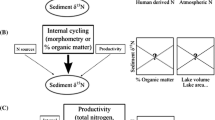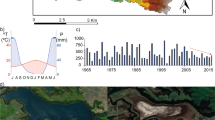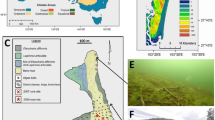Abstract
Five major factors control nutrient and organic matter inputs in high-Arctic lakes, all potentially affected by climate change: ice cover; run-off from the watershed; aquatic and terrestrial primary productivity; guano deposition from birds. Quantifying these controls is a key first step to understand what combination of factors underlies the biological productivity in Arctic lakes and drives their ecological response to climate change. Based on C and N elemental content and stable isotope analysis in sediments belonging to three lakes in North Spitsbergen (Svalbard), Digital Elevation Models and drainage maps, we propose an integrated approach for the analysis of nutrient and organic matter inputs in lakes and the role of catchment hydro-geomorphology in determining inter-lake differences in the isotopic composition of sediments. Given its high run-off and large catchment, organic deposits in Tvillingvatnet were dominated by terrestrial inputs, whereas inputs were mainly of aquatic origin in Storvatnet, a lowland lake characterised by low potential run-off. In Kolhamna, organic deposits seemed to be dominated by inputs from birds. Isotopic signatures were similar between samples within each lake, representing precise tracers for studies on the effect of climate change on biogeochemical cycles in lakes. The presented approach proved to be an effective research pathway for the identification of factors underlying nutrient and organic matter inputs within each water body, as well as for the modelling of expected changes in nutrient content associated with changes in isotopic composition of sediments.




Similar content being viewed by others
References
ACIA (2005) Arctic climate impact assessment. Cambridge University Press, New York
Basset A, Rossi L (1990) Competitive trophic niche modifications in three populations of detritivores. Funct Ecol 4:685–694
Bentivoglio F, Calizza E, Rossi D, Carlino P, Careddu G, Rossi L, Costantini ML (2015) Site-scale isotopic variations along a river course help localize drainage basin influence on river food webs. Hydrobiologia. doi:10.1007/s10750-015-2597-2
Blais JM, Kimpe LE, McMahon D, Keatley BE, Mallory ML, Douglas MS et al (2005) Arctic seabirds transport marine-derived contaminants. Science 309:445
Burrough PA (1986) Principles of geographic information systems for land resources assessment. Oxford University Press, New York
Calizza E, Costantini ML, Rossi D, Carlino P, Rossi L (2012) Effects of disturbance on an urban river food web. Fresh Biol 57:2613–2628
Calizza E, Costantini ML, Carlino P, Bentivoglio F, Orlandi L, Rossi L (2013a) Posidonia oceanica habitat loss and changes in litter-associated biodiversity organization: a stable isotope-based preliminary study. Estuar Coast Shelf Sci 135:137–145
Calizza E, Rossi L, Costantini ML (2013b) Predators and resources influence phosphorus transfer along an invertebrate food web through changes in prey behaviour. PLoS One 8(6):e65186. doi:10.1371/journal.pone.0065186
Calizza E, Aktan Y, Costantini ML, Rossi L (2015) Stable isotope variations in benthic primary producers along the Bosphorus (Turkey): a preliminary study. Mar Pollut Bull 97:535–538
Careddu G, Costantini ML, Calizza E, Carlino P, Bentivoglio F, Orlandi L, Rossi L (2015) Effects of terrestrial input on macrobenthic food webs of coastal sea are detected by stable isotope analysis in Gaeta Gulf. Estuar Coast Shelf Sci 154:158–168
Costantini ML, Rossi L (2010) Species diversity and decomposition in laboratory aquatic systems: the role of species interactions. Fresh Biol 55:2281–2295
Costantini ML, Zaccarelli N, Mandrone S, Rossi D, Calizza E, Rossi L (2012) NDVI spatial pattern and the potential fragility of mixed forested areas in volcanic lake watersheds. For Ecol Manag 285:133–141
Costantini ML, Calizza E, Rossi L (2014) Stable isotopes variation during fungal colonization of leaf detritus in aquatic environments. Fungal Ecol 11:154–163
Costanzo SD, O’Donohue MJ, Dennison WC, Loneragan NR, Thomas M (2001) A new approach for detecting and mapping sewage impacts. Mar Pollut Bull 42:149–156
Fazi S, Rossi L (2000) Effects of macro-detritivores density on leaf detritus processing rate: a macrocosm experiment. Hydrobiologia 435:127–134
Fry B (2007) Stable isotope ecology. Springer, New York
Hai WW (2014) The accelerating rate of global change. Rend Fis Acc Lincei 25:29–48
Hall RI, Small JP (1993) The influence of catchment size on lake trophic status during the hemlock decline and recovery (4800–3500 BP) in southern Ontario lakes. Hydrobiologia 269:371–390
Hladyz S, Gessner MO, Giller PS, Pozo J, Woodward G (2009) Resource quality and stoichiometric constraints on stream ecosystem functioning. Fresh Biol 54:957–970
Hobbie JE, Peterson BJ, Bettez N, Deegan L, O’Brien WJ, Kling GW, Kipphut GW, Bowden WB, Hershey AE (1999) Impact of global change on the biogeochemistry and ecology of an Arctic freshwater system. Polar Res 18:207–214
Ianniello A et al (2016) Air-snow exchange of reactive nitrogen species at Ny-Ålesund, Svalbard (Arctic). Rend Fis Acc Lincei (this issue)
Jona-Lasinio G, Costantini ML, Calizza E, Pollice A, Bentivoglio F, Orlandi L, Careddu G, Rossi L (2015) Stable isotope-based statistical tools as ecological indicator of pollution sources in Mediterranean transitional water ecosystems. Ecol Indic 55:23–31
Knoll AH (2009) The coevolution of life and environment. Rend Fis Acc Lincei 20:301–306
Lakka HK (2013) The ecology of a freshwater crustacean: Lepidurus arcticus (Branchipoda; Notostraca) in a high arctic region. Dissertation, University of Helsinky
Mancinelli G, Pasquali V (2016) Body-size related constraints on the movement behaviour of the arctic notostracan Lepidurus arcticus (Pallas, 1973) under laboratory conditions. Rend Fis Acc Lincei (this issue)
Moore ID, Grayson RB, Ladson AR (1991) Digital terrain modeling: a review of hydrological, geomorphological and biological applications. Hydrol Process 5:3–30
Orlandi L, Bentivoglio F, Carlino P, Calizza E, Rossi D, Costantini ML, Rossi D (2014) δ15N variation in Ulva lactuca as a proxy for anthropogenic nitrogen inputs in coastal areas of Gulf of Gaeta (Mediterranean Sea). Mar Pollut Bull 84:76–82
Papi F, Gudmundsson GA, Benvenuti S, Alerstam T, Åkesson S (1993) Migratory flights of Arctic geese tracked by satellite. Rend Fis Acc Lincei 4:153–156
Pasquali V (2015) Locomotor activity rhythms in high arctic freshwater crustacean: Lepidurus arcticus (Branchiopoda; Notostraca). Biol Rhythm Res 46:453–458
Post E, Forchhammer MC, Bret-Harte MS, Callaghan TV, Christensen TR, Elberling B et al (2009) Ecological dynamics across the Arctic associated with recent climate change. Science 325:1355–1358
Prop J, de Vries J (1993) Impact of snow and food conditions on the reproductive performance of barnacle geese Branta leucopsis. Ornis Scand 24:110–121
Prowse TD, Wrona FJ, Reist JD, Gibson JJ, Hobbie JE, Levesque LMJ, Vincent WF (2006) Climate change effects on hydroecology of Arctic freshwater ecosystems. Ambio 35:347–358
Rooney N, McCann KS (2012) Integrating food web diversity, structure and stability. Trends Ecol Evol 27:41–46
Rossi L, Costantini ML, Carlino P, di Lascio A, Rossi D (2010) Autochthonous and allochthonous plant contributions to coastal benthic detritus deposits: a dual-stable isotope study in a volcanic lake. Aquatic Sci 72:227–236
Rossi L, di Lascio A, Carlino P, Calizza E, Costantini ML (2015) Predator and detritivore niche width helps to explain biocomplexity of experimental detritus-based food webs in four aquatic and terrestrial ecosystems. Ecol Compl 23:14–24
Spolaor A, Barbaro E, Christille JM et al (2016) Evolution of the Svalbard annual snow layer during the melting phase. Rend Fis Acc Lincei (this issue)
Valt M, Salvatori R (2016) Snowpack characteristics of Brøggerhalvøya, Svalbard Islands. Rend Fis Acc Lincei (this issue)
Van Geest GJ, Hessen DO, Spierenburg P, DahlHansen GAP, Christensen G, Brehm M, Loonen MJJE, Faerovig PJ, Van Donk E (2007) Goose-mediated nutrient enrichment and planktonic grazer control in arctic freshwater ponds. Oecologia 153:653–662
Vaze J, Teng J, Spencer G (2010) Impact of DEM accuracy and resolution on topographic indices. Environ Model Softw 25:1086–1098
Vincent WF, Hobbie JE, Laybourn-Parry J (2008) Introduction to the limnology of high-latitude lakes and river ecosystems. In: Laybourn-Parry J, Vincent WF (eds) Polar lakes and rivers: limnology of Arctic and Antarctic aquatic ecosystems. Oxford University Press, Oxford, pp 1–24
Weibel R, Heller M (1991) Digital terrain modelling. In: Maguire DJ, Goodchild MF, Rhind DW (eds) Geographical information systems, vol 1. Longman, Harlow, pp 269–297
Wilson JP, Gallant JC (2000) Digital terrain analysis. In: Wilson JP, Gallant JC (eds) Terrain analysis: principles an applications. Wiley, New York, pp 1–27
Acknowledgments
This research has been conducted within the two Projects RIS-10242 (PI: E. Calizza) and RIS-10011 (PI: V. Pasquali) and was supported by Sapienza University Grants 2012. Authors wish to thank the CNR (Italy) for logistical support and Vetro Scientifica s.r.l. (www.vetroscientifica.it; Rome, Italy) for providing high-quality laboratory materials.
Author information
Authors and Affiliations
Corresponding author
Additional information
This peer-reviewed article is a result of the multi- and inter-disciplinary research activities based at the Arctic Station “Dirigibile Italia”, coordinated by the “Dipartimento Scienze del Sistema Terra e Tecnologie per l’Ambiente” of the National Research Council of Italy.
Electronic supplementary material
Below is the link to the electronic supplementary material.
Rights and permissions
About this article
Cite this article
Calizza, E., Costantini, M.L., Rossi, D. et al. Stable isotopes and digital elevation models to study nutrient inputs in high-arctic lakes. Rend. Fis. Acc. Lincei 27 (Suppl 1), 191–199 (2016). https://doi.org/10.1007/s12210-016-0515-9
Received:
Accepted:
Published:
Issue Date:
DOI: https://doi.org/10.1007/s12210-016-0515-9




